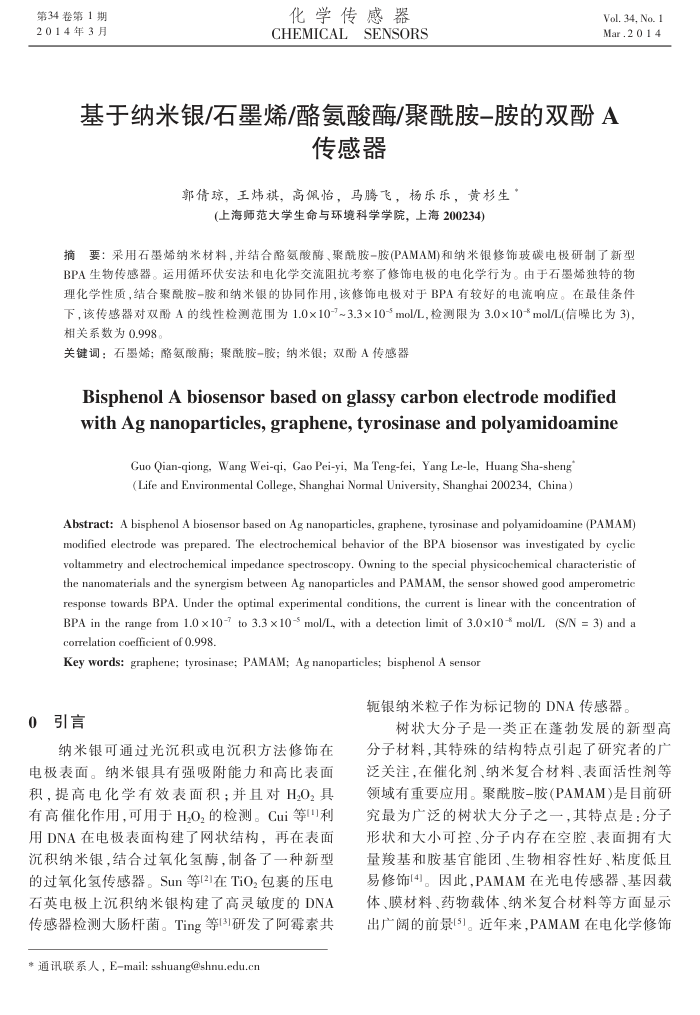基于纳米银∕石墨烯∕酪氨酸酶∕聚酰胺-胺的双酚A传感器
内容简介
 第34卷第1期 2014年3月
第34卷第1期 2014年3月化学传感器 CHEMICALSENSORS
Vol. 34, No. 1 Mar.2014
基于纳米银/石墨烯/酪氨酸酶/聚酰胺-胺的双酚A
传感器
郭倩琼,王炜祺,高佩怡,马腾飞,杨乐乐,黄杉生“
(上海师范大学生命与环境科学学院,上海200234)
摘要:采用石墨烯纳米材料,并结合酪氨酸酶、聚酰胺-胺(PAMAM)和纳米银修饰玻碳电极研制了新型 BPA生物传感器。运用循环伏安法和电化学交流阻抗考察了修饰电极的电化学行为。由于石墨烯独特的物理化学性质,结合聚酰胺-胺和纳米银的协同作用,该修饰电极对于BPA有较好的电流响应。在最佳条件
相关系数为0.998。
关键调:石墨烯;酪氨酸酶;聚酰胺-胺;纳米银;双酚A传感器
BisphenolAbiosensorbasedonglassycarbonelectrodemodified with Ag nanoparticles, graphene, tyrosinase and polyamidoamine
Guo Qian-qiong, Wang Wei-qi, Gao Pei-yi, Ma Teng-fei, Yang Le-le, Huang Sha-sheng(Life and Environmental College, Shanghai Normal University, Shanghai 200234, China )
Abstract: A bisphenol A biosensor based on Ag nanoparticles, graphene, tyrosinase and polyamidoamine (PAMAM) modified electrode was prepared. The electrochemical behavior of the BPA biosensor was investigated by cyclic voltammetry and electrochemical impedance spectroscopy. Owning to the special physicochemical characteristic of the nanomaterials and the synergism between Ag nanoparticles and PAMAM, the sensor showed good amperometric response towards BPA. Under the optimal experimental conditions, the current is linear with the concentration of BPA in the range from 1.0 ×10-7 to 3.3 × 10-S mol/L, with a detection limit of 3.0x10 mol/L (S/N = 3) and a correlation coefficient of 0.998.
Key words: graphene; tyrosinase; PAMAM; Ag nanoparticles; bisphenol A sensor
0引言
纳米银可通过光沉积或电沉积方法修饰在电极表面。纳米银具有强吸附能力和高比表面积,提高电化学有效表面积;并且对H02具有高催化作用,可用于H,O,的检测。Cui等利用DNA在电极表面构建了网状结构,再在表面沉积纳米银,结合过氧化氢酶,制备了一种新型的过氧化氢传感器。Sun等[2]在TiO2包裹的压电石英电极上沉积纳米银构建了高灵敏度的DNA 传感器检测大肠杆菌。Ting等到研发了阿霉素共
*通讯联系人,Email:sshuang@shnu.edu.cn
轭银纳米粒子作为标记物的DNA传感器。
树状大分子是一类正在蓬勃发展的新型高分子材料,其特殊的结构特点引起了研究者的广泛关注,在催化剂、纳米复合材料、表面活性剂等领域有重要应用。聚酰胺-胺(PAMAM)是目前研究最为广泛的树状大分子之一,其特点是:分子形状和大小可控、分子内存在空腔、表面拥有大量羧基和胺基官能团、生物相容性好、粘度低且易修饰[4)。因此,PAMAM在光电传感器、基因载体、膜材料、药物载体、纳米复合材料等方面显示出广阔的前景[5]。近年来,PAMAM在电化学修饰